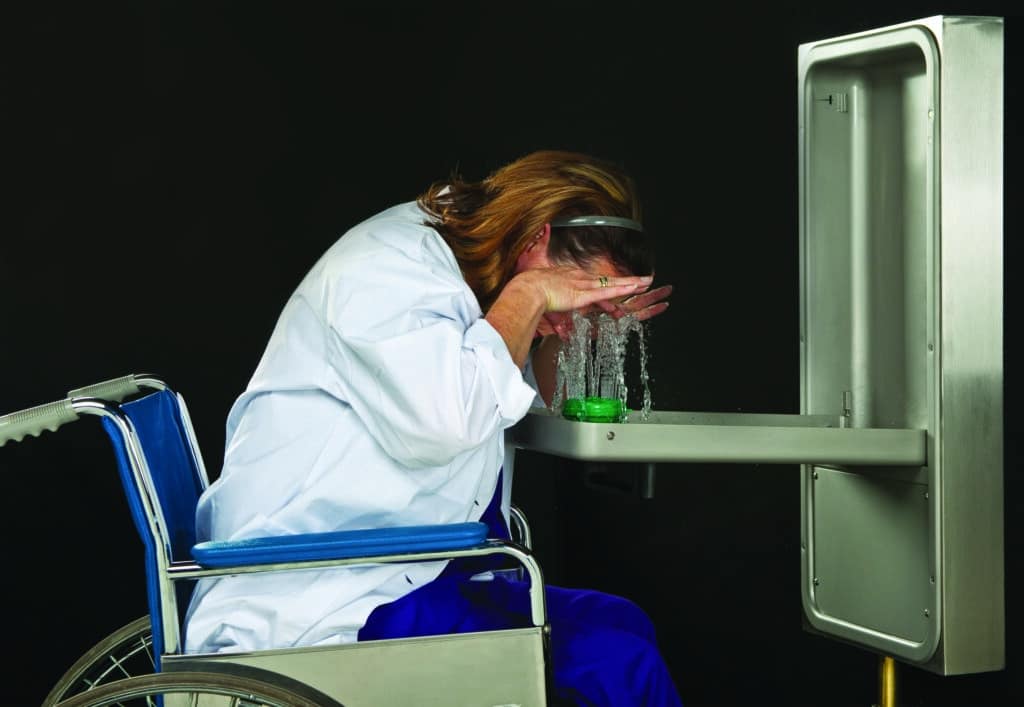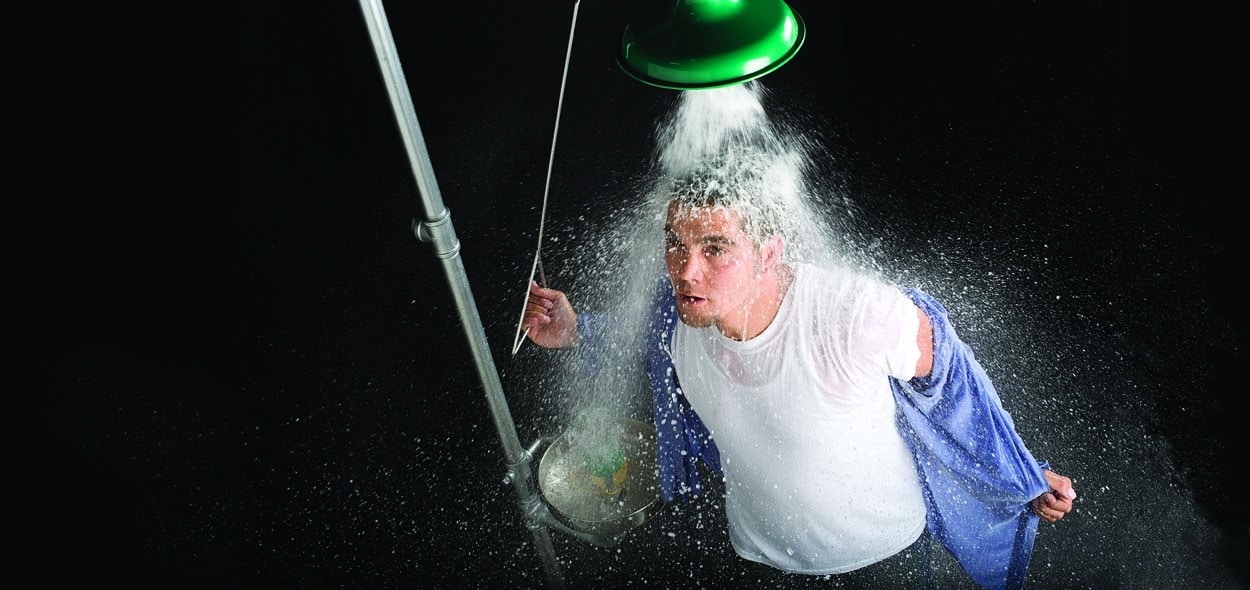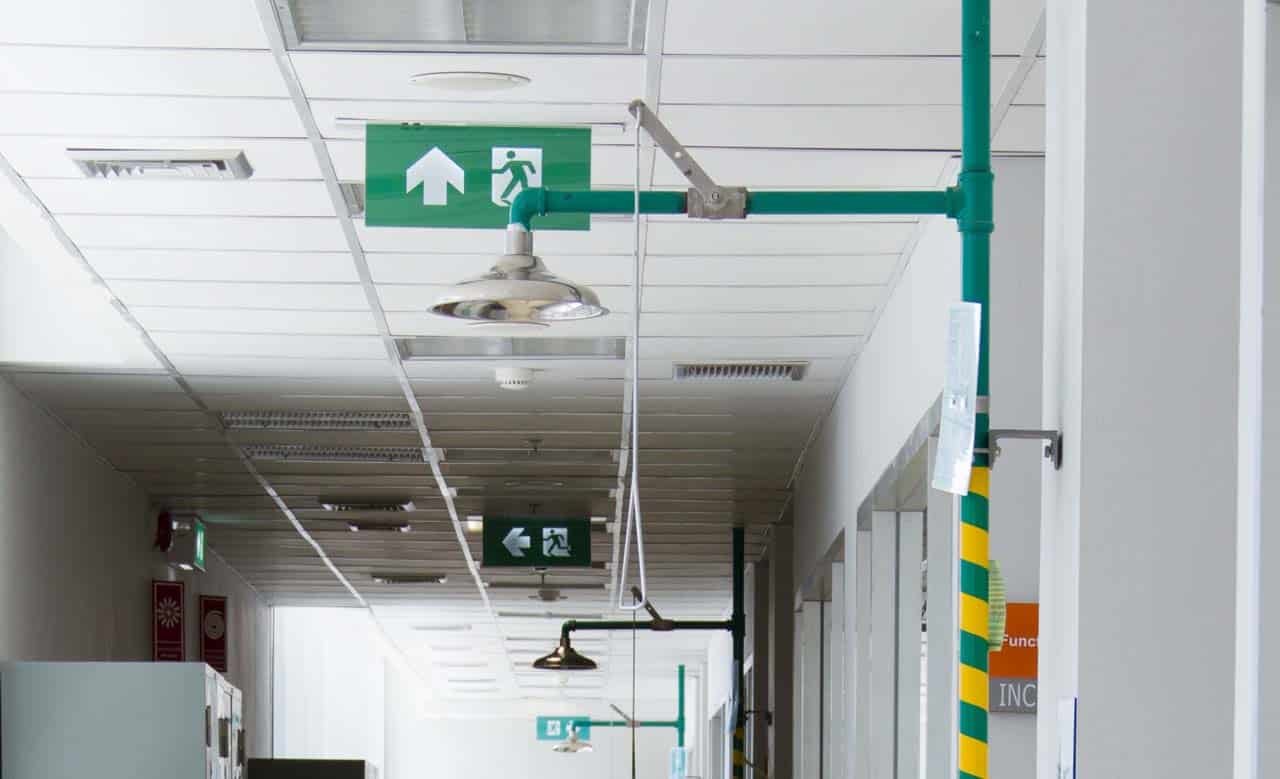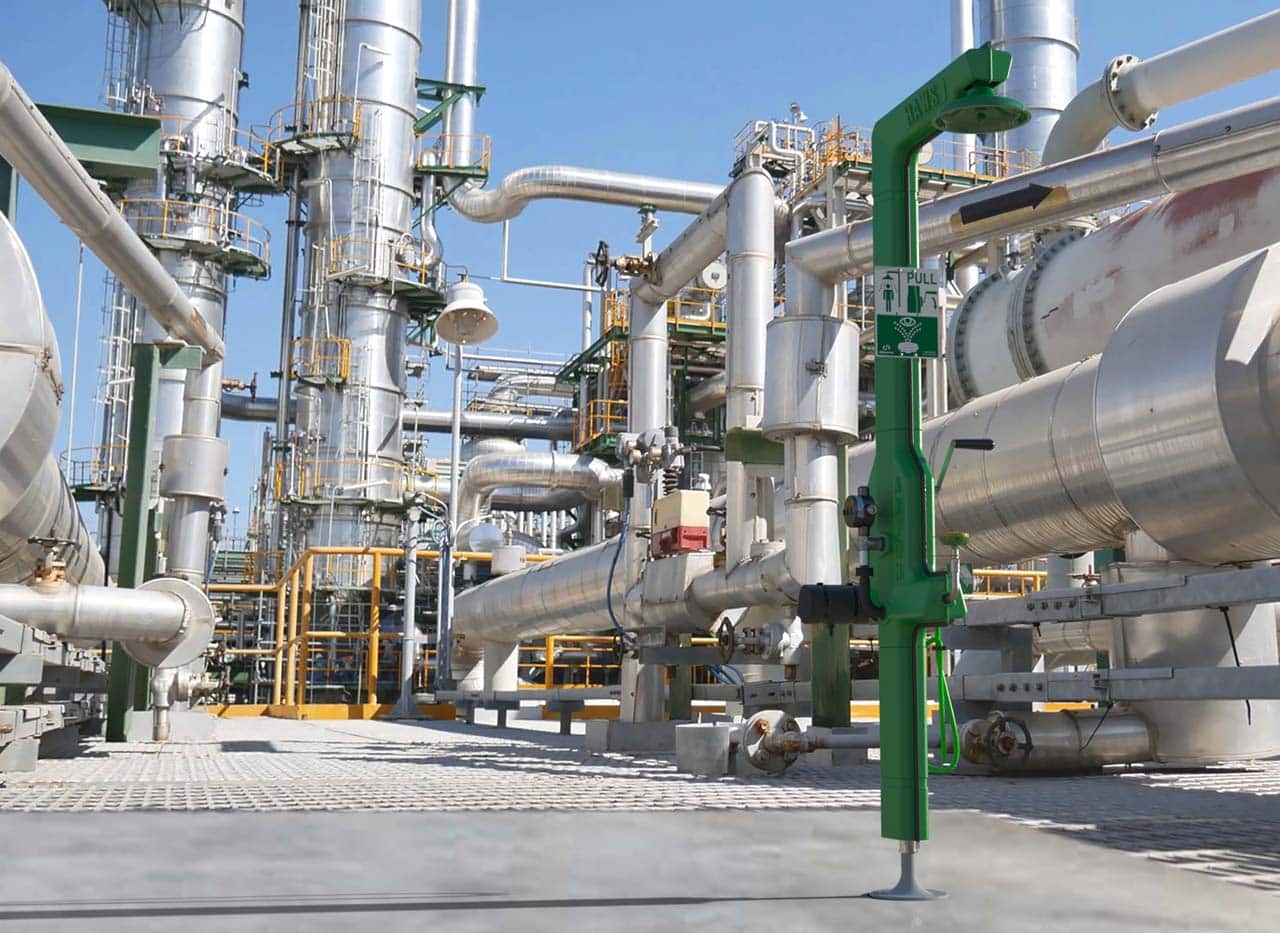18 March 2024
The safety and wellbeing of employees should always be a top priority for any business or organization. In any workplace where hazardous materials or chemicals are used, the risk of eye injuries is significant. For this reason, plumbed-in Eyewash Stations are essential safety equipment that can provide immediate first aid in the event of an eye injury.In this article, we will answer the most important questions about plumbed-in Eyewash Stations according to international standards as EN 15154-2 or ANSI Z358.1-2014(R2020). We will explain what plumbed-in Eyewash Stations are, when they are required, how to choose them, and how to maintain and test them. Additionally, we will give an overview on other eyewash systems and provide links to further information.
The most important facts at a glance
- Plumbed-in Eyewash Stations are crucial first aid devices that provide immediate decontamination of eyes and face in the event of accidental exposure to hazardous materials
- Eyewash Stations should be placed near the hazard in an easily accessible location, and regular testing must be performed to ensure they are in good working condition and can provide proper first aid
- To ensure proper performance and functionality, plumbed-in Eyewash Stations must comply with international standards such as EN 15154-2 or ANSI Z358.1-2014(R2020)
- Personal eyewash bottles are not a substitute for Eyewash Stations as they do not provide the required 15-minute rinsing time specified in international standard
Plumbed-in Eyewash Stations: what you should know
Plumbed-in Eyewash Stations are critical for providing immediate first aid in the event of an eye injury caused by hazardous materials or other harmful substances¹. They are commonly found in laboratories, medical facilities, storage locations, workshops, and production facilities. It is important to note that after using an emergency Eyewash Station, seeking medical attention is necessary to determine if any further treatment is required.
What are plumbed-in eye wash stations?
Emergency Eyewash Stations are designed to deliver a gentle flow of water to rinse the eyes, providing immediate first aid in the event of exposure to hazardous substances or materials that could cause eye damage. They are installed in fixed locations near hazardous areas and connected to a permanent source of potable water, such as the building’s plumbing system.
How do Eyewash Stations work?
Plumbed-in Eyewash Stations are designed to continuously provide a flow of clean water to flush out any hazardous substances that may have come into contact with the eyes. These devices can be activated by either a hand or foot control valve, directing a flow of water through one or more nozzles or spray heads. It is crucial that the water is delivered for a minimum of 15 minutes at a safe flow rate and pressure to ensure complete decontamination and prevent any further damage to the eyes.
What is the difference between Eyewashes and Eye/Face Washes?
While both Eyewashes and Eye/Face Washes are emergency equipment designed to provide relief for those who have been exposed to hazardous materials, they differ in their intended purpose and scope. Eyewashes are intended to rinse only the eyes with a gentle flow of water, removing any contaminants that may have come into contact with them. Eye/Face Washes, on the other hand, are intended to provide a more comprehensive solution, flushing contaminants from the entire face, including the eyes, nose, and mouth. The ANSI Z358.1-2014(R2020) standard differentiates between these two types, but the European standard EN 15154-2 does not. However, it is recommended to use an Eye/Face wash due to its higher flow rate, as it cannot be ruled out that in case of an accident, parts of the face may also need to be rinsed in addition to the eyes.
When do I need plumbed-in Eyewash Stations?
To ensure workplace safety, it’s mandatory to have emergency Eyewash stations in areas where hazardous materials, chemicals, or other harmful substances are present. Determining whether a plumbed-in Eyewash station or another safety system is adequate, depends on the nature of the hazards present. Conducting a site risk assessment and consulting safety datasheets, safety processes, and standards are crucial in making this determination. The GESTIS Substance Database is a useful resource for information on first aid measures and the recommended rinsing time for hazardous substances.
When do I need to install a plumbed-in eye wash station?
Eyewash units are not suitable for situations where there is a risk of injury to other parts of the body in addition to the eyes and face. In such cases, Combination Safety Showers are recommended to rinse the body and eyes simultaneously. If a reliable source of potable water cannot be ensured, then a plumbed-in Eyewash Station may not be a feasible solution. Instead, portable eyewashes with a tank are a better option as they can provide a 15-minute flush of the eyes and face with clean water.
Where should plumbed-in eye wash stations be installed?
Eyewash stations should be strategically located in areas where there is a risk of eye exposure to hazardous substances or materials. This requires conducting a thorough hazard assessment to determine the appropriate placement of the stations in the workplace. Factors such as the layout of the facility, the type of hazardous substances used and stored, and the number of workers who may need access to the Eyewash Station should be considered.
As a general rule, it is recommended to place emergency Eyewash Stations in easily accessible areas, close to hazardous zones or areas where hazardous substances are handled or stored. They should also be located on a level surface, with a clear and unobstructed path to the Eyewash. It is important to ensure that the Eyewash Station is clearly visible and identifiable, with highly visible signage to ensure that they can be easily located in an emergency. National standards may include additional requirements for the location of plumbed-in Eyewashes.
What are the different types of plumbed-in Eyewash stations?
Plumbed-in Eyewash stations come in a variety of designs, each tailored to specific needs. Laboratory units are commonly installed on sinks or decks in laboratory settings. Wall-mounted eyewash stations are versatile and can be found in various industries. Pedestal-mounted Eyewashes are ideal for workshops and production facilities. Additionally, there are barrier-free, handicapped-accessible, and recessed wall-mounted Eyewashes available for specialized settings.
What international standards apply to plumbed-in Eyewash Stations?
Guidelines for the design, installation, performance, and testing of plumbed-in Eyewashes are provided by the European standards EN 15154-2. The internationally recognized ANSI Z358.1-2014(R2020) standard defines the performance and installation requirements for both Eyewashes and Eye/Face washes². In addition, certain countries have their own national standards that must also be taken into account. These standards are essential in ensuring that eyewashes are capable of providing appropriate first aid and are operating in good working condition.
How much water does a plumbed-in Eyewash station need per Minute?
Eyewash standards require a flow rate of at least 6 liters per minute according to EN 15154-2. ANSI Z358.1-2014(R2020) mandates a minimum flow rate of 1.5 liters/minute (0.4 gpm) for Eyewash Stations and 11.4 liters/minute(3 gpm) for Eye/Facewash Stations². The minimum water flow duration is 15 minutes for both standards, and the water stream must have a low enough velocity to prevent eye injury.
What are the different types of shower heads?
Eyewash Stations rinses from below the face and eyes of the victim leaning over the Eyewash. Most Eyewashes are equipped with a shower head with two outlet nozzles that spray from the outside to the inside. This system is called “bullhorn”. Some Eye/Face Washes are even equipped with a bullhorn system that has four shower heads arranged crosswise. However, a common problem with all bullhorn systems is that the water jets are often unevenly strong, resulting in one eye receiving too much rinsing while the other does not receive enough. Alternatively, a unique type of shower head, the AXION® shower head, a patented technology of Haws Corporation, is centrally located and always rinses both eyes equally. Additionally, harmful substances are rinsed from the inside to the outside with this system, preventing them from entering the lacrimal glands and causing further injuries.
How much space do Eyewashes require?
To comply with EN 15154-2 and ANSI Z358.1 standards, Eyewash Stations must allow sufficient space for an accident victim to hold both eyelids open with their hands while their eyes are in the water stream. EN 15154-2 specifies outlet nozzle installation at 1000 mm (± 200 m) above floor level, with a minimum 150 mm distance from the wall or nearest obstacle, while ANSI Z358.1-2014(R2020) requires a flow pattern between 838 mm (33 in) and 1346 mm (53 in) high from the surface and a minimum 153 mm (6 in) distance from the nearest obstruction or wall. Additionally, both standards define the height and pattern of the water jet.
What should be the water temperature for Eyewash stations?
The sensitivity of the eyes to temperature makes it crucial to ensure that the water temperature provided by the Eyewash Station is within a safe range, as water that is too hot or too cold may discourage injured persons from flushing their eyes for the recommended 15 minutes.
ANSI Z358.1-2014(R2020) mandates a water temperature range of 16 °C to 38 °C for Eyewashes, while EN 15154-2 suggests a range of 15 °C to 37 °C. However, additional regulations regarding water temperature may be present in national standards.
How often do I need to check an Eyewash station?
Regular inspection and maintenance of emergency Eyewash stations is crucial, and the frequency of inspections may vary depending on local regulations and standards. For example, the ANSI Z358.1-2014(R2020) standard specifies that Eyewashes and Eye/Face Washes must be checked weekly to ensure proper functioning, while EN 15154-2 references the manufacturer’s corresponding test and maintenance instructions. Eyewash Stations should be inspected after any significant event, such as a power outage, maintenance work, or an accident, to ensure they are still in good working condition.
What are the alternatives to plumbed-in emergency Eyewash Stations?
Apart from plumbed-in eyewashes and eye/facewashes, there are other response systems available that can provide immediate first aid in the event of an eye injury³:
- Portable Eyewashes
- Persoanal Eyewash bottles
- Combination Safety Showers
Portable eyewashes
Portable eyewashes allow rinsing of the eyes for at least 15 minutes. They typically consist of a tank containing water or a rinsing liquid and are intended for use in mobile settings or locations without a reliable supply of clean drinking water. There are two main types of portable Eyewashes: non-pressurized systems with a plastic tank that rely on gravity to release the flushing liquid and have a capacity of around 25 to 60 liters, and pressurized systems with stainless steel tanks that use overpressure to release the water or rinsing liquid.
Personal Eyewash bottles
Personal Eyewash bottles are not meant to replace plumbed-in Eyewashes or Eye/Face Washes, but eyewash bottles can be a vital first-aid tool to minimize damage to the eyes during the critical initial moments after an accident. They are a great addition to any workplace first aid kit, as they can provide immediate relief to an injured person until they can access a plumbed-in Eyewash Station.
They come in a variety of sizes, typically ranging from 500 to 1000 ml of flushing solution. It’s important to note that eyewash bottles have a limited capacity and can only provide a few minutes of flushing time, making it essential to have a permanent Eyewash Station available for prolonged flushing if required. Therefore, it is recommended to have both personal Eyewash bottles and permanent Eyewash stations installed in a workplace for optimal emergency preparedness.
Combination Safety Showers
Combination Emergency Showers are safety units that combine an Eyewash Station and a Body Safety Shower in one unit. hey are used when there is a risk of exposure to hazardous substances for both the eyes and body. Combination Safety Showers provide an immediate and comprehensive emergency response solution in case of exposure to hazardous materials, allowing for both flushing simultaneously of the eyes and body.
Conclusion
Plumbed-in Eyewash stations play a crucial role in emergency response plans in industrial and laboratory settings, providing immediate first aid in case of accidental exposure of eyes and face to hazardous materials. Compliance to international standards like EN 15154-2 and ANSI Z358.1-2014(R2020) is vital to ensure proper performance and functionality. To ensure they can provide proper first aid during emergencies, regular inspection, testing, and maintenance of Eyewash Stations is necessary. Other safety systems like portable Eyewash Stations, personal eyewash bottles, and Combination Safety Showers offer additional emergency response options in the workplace.
Further information:
Haws Eyewash Stations
Haws Portable Eyewash Stations
Haws Combination Showers
Haws Laboratory Safety Units
Haws Tepid Water Solutions
References
1. Benchmarkinc.com: Eye Wash Stations: What Are They & How to Use
2. Ccohs.ca: Emergency Showers and Eyewash Stations
3. Creativesafetysupply.com: Why are emergency eye wash stations important?
Our opening hours during holidays12 December, 2024

As we approach the festive season, we would like to update you on our special opening hours during the holidays:
- Monday, December 25: Closed
- Tuesday, December 26: Closed
- Wednesday, December 27: Open from 9:00 to 14:00 CET
- Thursday, December 28: Open from 9:00 to 14:00 CET
- Friday, December 29: Open from 9:00 to 14:00 CET
- Monday, January 1: Closed
- Tuesday, January 2: Closed
- Starting Wednesday, January 3: Regular opening hours
The whole Haws EMEA Team wishes you a joyful holiday season.
Haws® Corporation Appoints Chuck Gruber as New CEOPromotion showcases Haws’ dedication to increased growth, high standards, and agility
Sparks, NV—October 13, 2023—Haws Corporation, a leading global manufacturer of hydration and safety equipment, is pleased to announce the appointment of Chuck Gruber as its new President and CEO. Mr. Gruber, a well-established industry leader in the manufacturing and safety space, joined the Haws Board of Directors in 2017 before becoming company President in 2020. This new appointment confirms Haws’ commitment to growth, innovation, and improving the health and safety of the global community.
“Chuck brings a new level of leadership to our 100+ year-old family-owned company. The teamwork and results our Haws team has demonstrated under Chuck’s leadership thus far has given the family the confidence to be able to transition to ownership responsibilities solely,” shares Tom White, Owner, Chairman and prior CEO. “With a proven track record of doubling company sales in under 5 years at the last companies he led, Haws is well positioned for growth now more than ever.”
After 30 years of working at Haws in various roles, Tom White, will continue in his role as Haws Chairman in addition to pursuing his personal interest to support and be a thought leader in family business governance. Stephanie Kilroy, Owner, will continue to drive the importance of company culture and growth through her participation in the Haws family governance.
While Gruber is the first Haws CEO from outside the founding family, Haws continues to be owned by family members and upholds the same values since its beginnings in 1906. “Haws places great importance on maintaining our company values as a family-owned business, while developing and maintaining high quality hydration and safety solutions. Chuck was an obvious choice to lead Haws through this next chapter,” commented Stephanie Kilroy.
In addition to his leadership record, Gruber’s professional experience includes roles in engineering, marketing, manufacturing, procurement, and global supply chain. Gruber holds a BS in Chemical Engineering from New Jersey Institute of Technology and an MBA from Temple University in Philadelphia.
About Haws Corporation: For more than 115 years, Haws has been improving the health and safety of our global community providing customer driven hydration, safety, and tempering solutions. With ownership held by fourth-generation family members of its founder, Haws operates under the mission to provide high-quality products and services with a focus on growth.
For media inquiries or more information, please contact:
Kathryn Loos, VP of Marketing and New Product Development, Haws
kathrynl@hawsco.com, +1.775.353.8390
05 September 2023
Haws EMEA has successfully achieved ISO recertification according to the international standards of ISO 9001, ISO 14001, and ISO 45001. This accomplishment is a proof to our unwavering dedication to quality, safety and environment.
Our Commitment to Quality, Safety and Environment
At Haws EMEA, quality, safety and environment have always been at the heart of everything we do. Our commitment to providing high-quality products and ensuring the safety of our customers is reflected in our daily operations. This recent recertification validates our ongoing efforts to maintain excellence in every aspect of our business.
ISO 9001 certification underscores our dedication to consistently meeting customer requirements and delivering exceptional quality. ISO 14001 certification demonstrates our dedication to environmental responsibility, ensuring that our operations have a minimal impact on the environment. ISO 45001 certification reaffirms our commitment to creating a safe and healthy workplace for our employees.
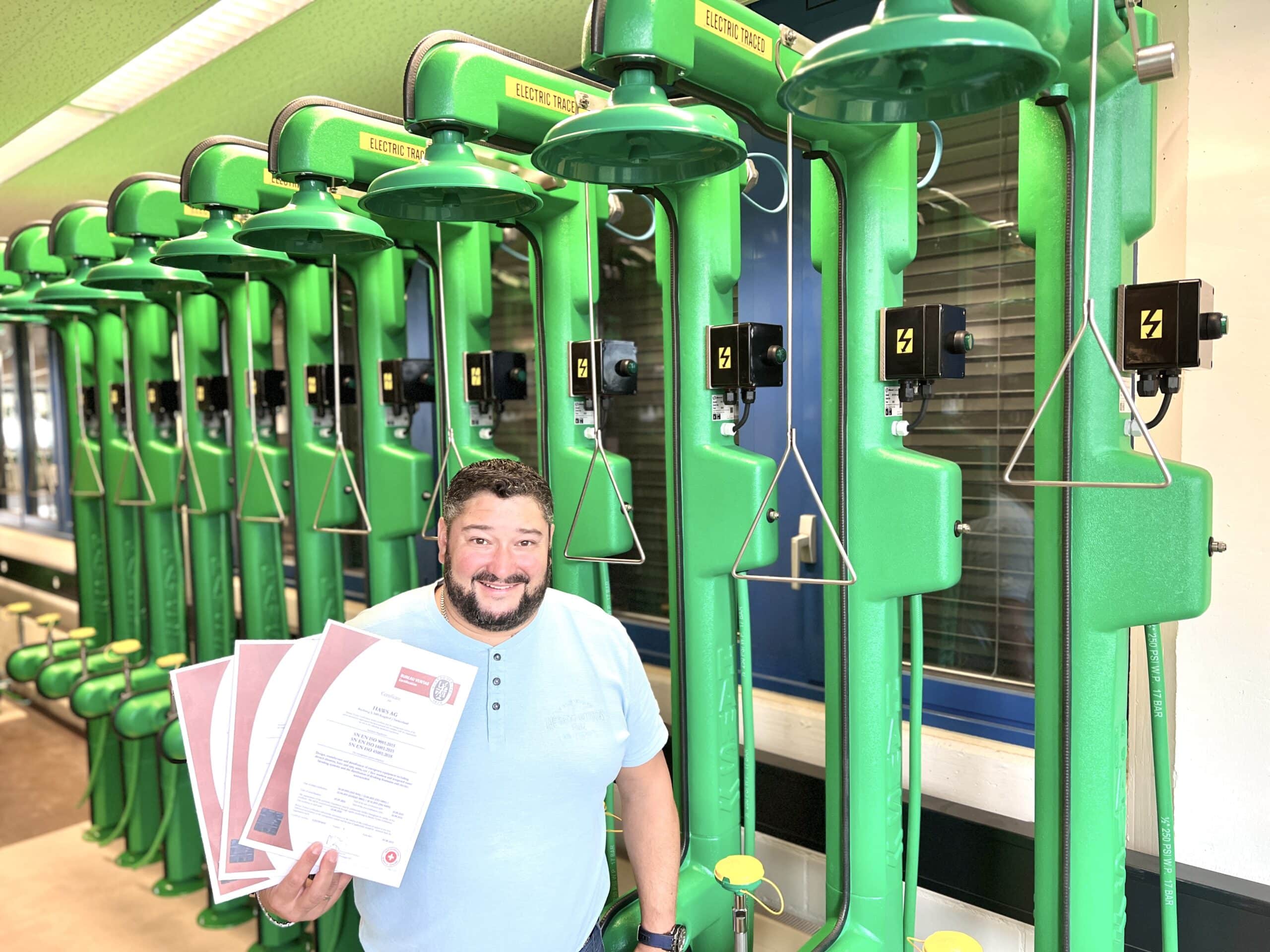
Haws EMEA has successfully achieved ISO recertification according to the international standards of ISO 9001, ISO 14001, and ISO 45001.
“This ISO recertification affirms our commitment to delivering products that meet the highest standards of quality, safety and environment. It reflects the hard work and dedication of our entire team.“, stated Oliver Mägerli, Manager Operations.
We look forward to continuing to serve you with the same dedication and passion that has earned us these important certifications.
Safety showers: The most important questions and answers12 April 2023
Safety showers are a crucial component of any emergency response plan in industrial and laboratory settings. Very often these showers are also called drench showers or emergency showers. These emergency showers are designed to remove hazardous materials from the body in case of an accidental exposure. They are an essential safety measure to protect workers and minimize the risk of injury or harm in the workplace.
In this article we explain safety showers, answer the most frequently asked questions and deal with the criteria you need to consider for plumbed-in emergency showers. Last but not least, we give an overview on other emergency shower systems and provide links to further information.
The most important in a nutshell
- A safety shower is a first aid device that provides immediate decontamination of the body of hazardous materials in the event of an accidental exposure
- Safety showers must comply with International Standards, such as EN 15154-1, EN 15154-5 or ANSI Z358.1 to ensure proper performance and functionality
- Safety showers should be placed near the hazard in an easily accessible location and tested regularly to ensure they are in good working condition and can deliver proper first aid
- Safety showers should not be used when there is a risk of eye injury with hazardous chemicals or when a reliable supply of potable water is not available
Safety showers: what you should know
The Safety shower is a technical first aid device used in laboratories and manufacturing plants. They are used to provide first aid to persons in the event of accidents when persons come into contact with hazards like acid, alkalis, heat, flames and contamination. After using an emergency shower, the accident victim should have a medical examination.
What are Safety showers?
Safety showers are specialized showers that provide a high volume of water to rinse the full body in case of an accidental exposure to hazardous materials. They are typically installed near hazardous areas or areas where hazardous materials are used and stored.
How do Safety showers work?
Safety showers work by providing a continuous flow of water to remove hazardous materials from the body. The shower head is activated by pulling a lever or pressing a button, and the water flow should be sufficient to remove hazardous materials within 15 minutes.
When do I need to install safety showers?
Safety showers should be used in case of an accidental exposure to hazardous materials, such as chemicals, corrosives, or radioactive materials¹. Site risk assessment, safety datasheets and safety processes and standards will provide important information on the need for emergency showers. Workers should be trained on how to use emergency showers and the conditions under which they should be activated.
When shall I not install a safety shower?
Safety showers are not a suitable first aid device if there is a risk of the eyes coming into contact with hazardous material in addition to the body. The water jet of a shower is so strong that it can cause injuries to the eyes. If a reliable supply of drinking water in the required quantity and pressure cannot be ensured, a plumbed-in emergency shower is also not an appropriate solution.
Where should safety showers be located?
Safety showers should be located in an easily accessible location, near hazardous areas or areas where hazardous materials are used and stored. They should also be located on a level surface, with a clear and unobstructed path to the shower. National standards may include further requirements for the location of this type of showers.
What types of safety showers are available?
The most common type of safety showers are free-standing showers. They are mainly used in the industrial area. In laboratories, training facilities, wall- or ceiling-mounted showers are mostly used. A special type of emergency showers are barrier-free, handicapped-accessible executions.
Which international standards apply to safety showers?
The European standards EN 15154-1 (for laboratories) and EN 15154-5 (for other sites than laboratories), provide guidelines for the design, performance, and testing of safety showers. The internationally recognized ANSI.Z358.1 standard defines performance and installation of emergency showers and eyewashes². In addition, national standards apply in some countries, which must also be considered in the respective case. These standards ensure that emergency showers provide proper decontamination and are in good working condition.
How much water must a safety shower deliver?
A safety shower must supply a large amount of water for at least 15 minutes. The specific amount depends on the respective standard. Safety showers in laboratories must supply at least 60 litres per minute according to EN 15154-1. EN 15154-5 defines three classes for showers with different volume flows between 30 and over 100 litres per minute. According to ANSI Z358.1, an emergency shower must deliver at least 75.7 litres (20 gallons) per minute.
What temperature should the water of a safety shower have?
The temperature of the water delivered by emergency showers should be tepid, neither to warm nor too cold. If the water temperatures exceed 38 °C, the risk of scalding is increased, as well as the absorption of harmful chemicals through the skin. Prolonged contact with cold water below 16 °C increases the risk of thermal shock or even hypothermia. Too hot or too cold water may prevent injured persons from using the shower for the required 15 minutes needed for effective decontamination.
EN 15154-1 and EN 15154-5 recommend a water temperature between 15 °C and 37 °C. Water temperatures between 20 °C and 25 °C are defined as ideal. ANSI Z358.1 specifies a water temperature between 16 °C and 38 °C. As a sum-up, all these standards define very similar optimal temperature ranges for emergency shower water.
When should safety showers be heated?
Safety showers located in an environment where the temperature can drop below freezing should be heated. There is a risk that the water in the shower will freeze, making it impossible for the safety shower to function properly. It is also important to ensure that the valves and water supply lines are freeze-protected. However, a heated shower cannot substitute a system to supply tepid water.
How often do I need to check a safety shower?
It is essential to regularly inspect and maintain safety showers. However, the frequency of inspections may vary depending on the local regulations and standards³. For instance, the EN 15154-1 standard specifies that showers must be regularly checked and tested to ensure their proper functioning, and any defects or malfunctions must be promptly corrected. In addition, safety showers should also be checked after any significant event, such as a power outage, a maintenance work, or an accident, to make sure they are still in good working condition. Regular checks should also include testing the water temperature and flow rate, checking the water supply and drainage system, and verifying the proper functioning of any alarm and lighting systems.
What are the alternatives to safety showers?
In addition to safety showers, there are other emergency shower systems that can provide first aid in the workplace as eyewash units, combination showers, and overhead tank showers.
Eyewash units
Eyewash units are safety devices that are designed to flush out contaminants from the eyes in case of a chemical splash or other eye irritants. They are designed specifically for decontaminating the eyes and face. An eyewash unit typically consist of a eyewash head that spray a gentle stream of water over the eyes, washing away the irritant and helping to reduce the risk of eye damage. Eye wash units can be standalone units or integrated into combination showers that also provide body flushing capabilities.
Combination showers
Combination showers are units that combine both an eyewash unit and a safety shower in one unit. The purpose of combination showers is to provide a comprehensive solution for immediate emergency response in case of exposure to hazardous materials, allowing for both flushing simultaneously of the eyes and body.
Overhead Tank Showers
Overhead tank showers are safety showers that are designed with a tank installed above the showerhead. They are mainly used for remote locations or sites where a reliable water supply is not available. When activated, the water flows gravity-fed from the tank through the showerhead and provides a continuous stream of water. With a tank of 1600 l, an autonomous overhead tank shower delivers a compliant flush of 15 minutes. Very often, the water in the tank is chilled or heated, so that the water temperature does not exceed the defined temperature range.
Conclusion
Safety showers are an important component of emergency response plans in industrial and laboratory settings, providing immediate first aid in case of accidental exposure to hazardous materials. Compliance with international standards such as EN 15154-1, EN 15154-5, and ANSI Z358.1 is essential to ensure proper performance and functionality. Regular inspection, testing, and maintenance of safety showers is also necessary to ensure they are in good working condition. Other emergency systems such as eyewash stations, combination showers and overhead tank showers can provide additional emergency response options in the workplace.
Further information:
-
Haws Safety Showers
-
Haws Combination Showers
-
Haws Overhead Tank Showers
-
Haws Eyewash Units
-
Haws Tepid Water Solutions
References:
1. Safetyfirst.blog: Safe Ways To Use A Safety Shower In An Emergency
2. Redasafe.com: How to Comply with OSHA and ANSI Requirements for Emergency Safety Showers
3. Absorbentsonline.com: How Often Should Safety Showers Be Checked?
